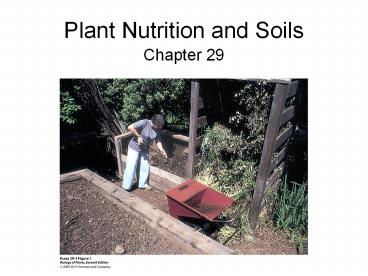Plant Nutrition and Soils - PowerPoint PPT Presentation
Title:
Plant Nutrition and Soils
Description:
Plant Nutrition and Soils Chapter 29 Plant Nutrition Plant Nutrition- uptake from the environment of all raw materials required for essential biochemical processes. – PowerPoint PPT presentation
Number of Views:299
Avg rating:3.0/5.0
Title: Plant Nutrition and Soils
1
Plant Nutrition and Soils
- Chapter 29
2
Plant Nutrition
- Plant Nutrition- uptake from the environment of
all raw materials required for essential
biochemical processes. - More than 60 elements have been identified in
plants. - 1880s- ten chemical elements were designated as
essential for plant growth. - Carbon, hydrogen, oxygen, potassium, calcium,
magnesium, nitrogen, phosphorus, sulfur, iron. - 1900s- manganese, zinc, copper, chlorine, boron,
molybdenum, and finally nickel.
17 Essential Elements
3
Essential Elements
- Three criteria are used to judge essentiality
- If it is needed for the plant to complete its
life cycle. - If it is part of any molecule or constituent of
the plant that is itself essential. - Magnesium in chlorophyll molecule.
- Nitrogen in proteins.
- If deficiency symptoms appear in the absence of
the element.
4
2 Types of Essential Elements
- Macronutrients- required in large amounts.
- 1000 mg/kg or gt of dry matter.
- Micronutrients (trace elements)- required in very
small amounts. - 100 mg/kg of dry matter.
- Certain plants contain unusually
high and low amounts of specific
elements.
Silicon
5
Macronutrient Functions
- Sulfur- amino acids and coenzyme A.
- Phosphorus- ATP, nucleic acids, phospholipids.
- Magnesium- chlorophyll molecule.
- Calcium- cell walls, cofactors, cellular
membrane. - Potassium- osmosis and ionic balance, stomatal
activity. - Nitrogen- amino acids, proteins, nucleotides,
nucleic acids, chlorophylls. - Oxygen, Carbon, and Hydrogen- almost all chemical
molecules, 96 of the plant.
6
Micronutrient Functions
- Molybdenum- nitrogen fixation and nitrate
reduction. - Nickel- enzyme functioning in nitrogen
metabolism. - Copper- involved in some REDOX reactions.
- Zinc- activator or component of many enzymes.
- Manganese- enzyme activator, membrane integrity,
oxygen release in PSN. - Boron- Ca2 utilization, nucleic acid synthesis,
membrane integrity. - Iron- chlorophyll synthesis.
- Chlorine- osmosis and ionic balance.
7
(No Transcript)
8
(No Transcript)
9
(No Transcript)
10
(No Transcript)
11
Global Nitrogen and Phosphorus Use
12
Nitrogen Losses
1500 lbs/day or 500/day!
13
Asynchrony Between N Supply and Demand
Source G. Philip Robertson IN Ecology in
Agriculture, L.E. Jackson, ed.
14
NUISANCE ALGAE BLOOMS
15
Eutrophication Lake Tahoe story
Data courtesy of C.R. goldman and J.E. Reuter,
Tahoe Reesrach Group, U. of California-Davis,
http//www.news.ucdavis.edu/tahoetv/
16
Soil
- Soil- primary nutrient (inorganic ions), water,
suitable gaseous environment, and support medium
for plants. - Provides a chemical and physical environment for
plant growth. - Minerals- naturally occuring inorganic compounds
that are usually composed of two or more
elements. i.e.- Quartz (SiO2), Calcite (CaCO3).
17
Soil Layers (Horizons)
- Soils consists of at least 3 horizons (layers)
- A Horizon topsoil.
- B Horizon subsoil.
- C Horizon soil base.
- Bedrock below the horizon.
18
Soils Are Composed of Solid Matter and Pore Space
- Solid Matter- fragments of rock and minerals in
the soil. - Coarse Sand 200-2000 µm
- Fine Sand 20-200 µm
- Silt 2-20 µm
- Clay lt 2 µm
- Pore Space- the space around the soil particles.
- Air
- Water
19
Plant Pathology- bacteria
20
Plant Pathology- viruses
21
Plant Pathology- fungi































